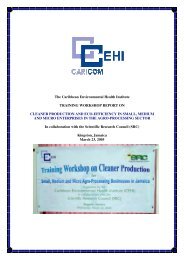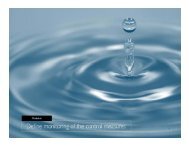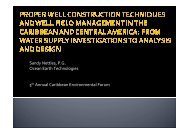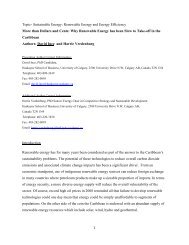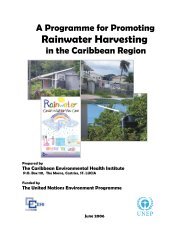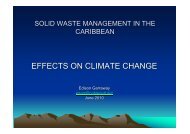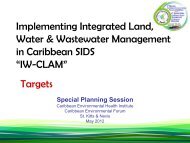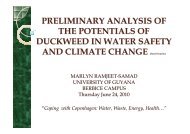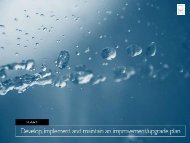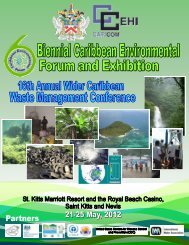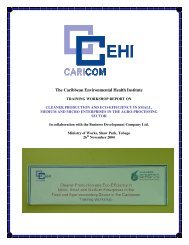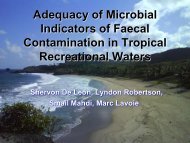conference magazine - Caribbean Environmental Health Institute
conference magazine - Caribbean Environmental Health Institute
conference magazine - Caribbean Environmental Health Institute
You also want an ePaper? Increase the reach of your titles
YUMPU automatically turns print PDFs into web optimized ePapers that Google loves.
Parallel Session 3 - Integrated Watershed<br />
and Coastal Areas Management (Port An-<br />
26<br />
tershed. The community of Au Leon, located within the Fond d’Or Nevis. The potable water extracted from this aquifer represents over<br />
Watershed, is a dense residential area that sits on a hillside. Due 40% of the total water supply for St. Kitts. The area is subject to urban<br />
to the topography, geology, and poor land and soil management<br />
practices in the area, much of the surface consist of exposed bedrock.<br />
encroachment, inappropriate land use and threats from pollution.<br />
A project was devised and implemented using an integrated approach<br />
As a consequence of this situation, few household septic to help government and communities take practical actions to protect<br />
tank systems are associated with effective ‘soakaways’; a system<br />
where wastewater filters through soil. Instead, most wastewater<br />
this vulnerable aquifer by demonstrating proper management and<br />
protection. The project is supported by the Global Environment Facility<br />
(GEF) as part of the Integrating Watershed and Coastal Areas<br />
(black and grey) is discharged directly into waterways such as<br />
gutters and gullies, and ultimately the river, impacting negatively<br />
on water quality in the area.<br />
Management (IWCAM) project for <strong>Caribbean</strong> Small Island States. The<br />
two major outcomes of the project are a water resources management<br />
plan and establishment of a National Park in the well-field area.<br />
A<br />
B<br />
S<br />
T<br />
R<br />
A<br />
C<br />
T<br />
S<br />
To address this aspect of poor waste water management within the<br />
community, a number of studies were undertaken including an<br />
assessment of pollutants within the community, as well as a baseline<br />
survey on sewage management in the community of Au Leon.<br />
Four demonstration waste water treatment wetlands were constructed<br />
to treat black water from septic tanks. Their design takes<br />
into account the topography of the area, as well as the use of locally<br />
available materials.<br />
This paper discusses the activities undertaken as part of this pilot<br />
project, including the major role of the community in the implementation<br />
of the project, as well as the key lessons learnt.<br />
Using GIS to monitor the potential impact of development on<br />
water supply and coastal zone management in Barbados by<br />
Alex Ifill<br />
Between 1990 and 2009, forty one thousand building lots have<br />
been submitted for development in Barbados. Given the “waterscare”<br />
nature of the country, the already high population density<br />
and potential impact on both fresh and marine water resources,<br />
the environmental impact of such development must be closely<br />
monitored.<br />
Given the water scarce status of the country there could be significant<br />
challenges in responding to drought as the island approaches<br />
its limit of renewable water resources. Secondly, recent studies<br />
have shown increasing nitrates in the groundwater. This trend<br />
mirrors the increasing population density as one moves towards<br />
the coast. This is of significant importance to the management of<br />
the marine environment.<br />
A comprehensive hydrogeologic evaluation of the aquifer was undertaken.<br />
Traditional methods and novel techniques were utilized to better<br />
understand and characterize the aquifer. The paper will highlight<br />
the main findings of the study including hydrogeologic interpretations,<br />
water quality analysis and modelling of contaminant transport and<br />
pumping regimes under various scenarios. Multi-electrode electrical<br />
resistivity (MER), a novel surface geophysical technique, was used to<br />
delineate the thickness and distribution of sediments throughout the<br />
aquifer, zones of increased porosity, zones of possible contamination<br />
and the fresh/salt water interface.<br />
At present, the majority of the Basseterre Valley watershed is vegetated<br />
land with over 30% representing disused government-owned<br />
sugar cane fields. As a result, there is a lot of pressure to develop<br />
these lands. The transformation of the landscape has brought with it<br />
associated pollution threats. In addition, a review of environmental<br />
laws and policies revealed a fragmented approach to water issues<br />
exacerbated by weak enforcement. An action plan with various time<br />
horizons was devised to cope with these issues and will be discussed<br />
in this paper.<br />
The cornerstone of the project was the establishment of a National<br />
Park around the sensitive well-field area. A park management plan<br />
was also devised. This final component serves to unify the scientific<br />
data uncovered as part of the water resources assessment, the legal<br />
actions taken to update water legislation and to declare the protected<br />
area and the involvement of key stakeholders, all of which are key<br />
ingredients for success. This project is novel and multi-faceted in its<br />
approach to protect a vulnerable coastal aquifer.<br />
Capacity building with a new paradigm in environmental management:<br />
the Integrated Watershed and Coastal Area Management in<br />
Cienfuegos, Cuba by Ángel R. León Pérez, María E. Castellanos<br />
González and Dra. Clara E. Miranda Vera<br />
A GIS package based on ArcView 3.2 was developed to analyse<br />
the potential impact of the development over the period 1990 to<br />
2009 on the water supply and groundwater quality.<br />
Combining sound science, legal action and stakeholder involvement<br />
to protect a vulnerable coastal aquifer on the island<br />
of St. Kitts by Halla Sahely, Sandy Nettles, Ravidya Burrowes<br />
and Glenn Haas<br />
The unconfined coastal aquifer underlying the Basseterre Valley is<br />
a significant economic and social asset for the people of St. Kitts-<br />
The application of Integrated Coastal Zone Management (ICZM) is<br />
necessary for the sustainable development in Cuba. However, for<br />
successful environmental management of these areas, it is necessary<br />
to merge the conceptual frame of the ICZM with that of Integrated<br />
Watershed and Coastal Area Management (IWCAM) in addition to<br />
incorporating an environmental and social perspective.<br />
This paradigm shift has been incorporated within the ICZM Capacity<br />
Building Programme of Cienfuegos University, the Centre of Environment<br />
Research of Cienfuegos (CEAC) and other universities since<br />
2002. The initiative has been sponsored by University Partnerships in<br />
Cooperation and Development and the Canadian International Development<br />
Agency. The objectives of the present paper are: 1) to argue<br />
FIFTH BIENNIAL CARIBBEAN ENVIRONMENTAL FORUM AND EXHIBITION




